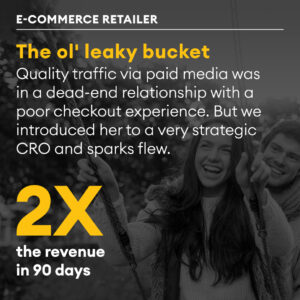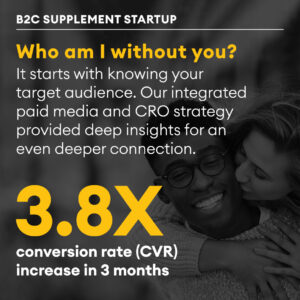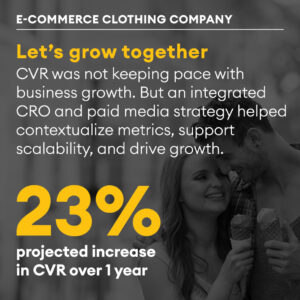For a few months every four years, the U.S. presidential election and Summer Olympics dominate the media landscape and create major challenges for advertisers trying to establish reach, maintain ad frequency, and meet cost per acquisition (CPA) goals. From roughly mid-July to early November, election campaigns and Olympic promotions overtake ad inventory, limiting supply and driving up costs for other advertisers.
In 2020, the Tokyo Olympics attracted $2.25 billion in U.S. ad revenue and the U.S. election cycle totaled an unprecedented $2.5 billion of ad revenue. And that’s just for TV ads! With all of that extra competition in the market, breaking through the clutter and maintaining effective reach and frequency without breaking the bank becomes a major challenge for most advertisers.
Let’s explore how a thoughtful election- and Olympic-year paid media strategy can help you emerge victorious from this quagmire. After all, who doesn’t love a good underdog story?
Politics and pentathlons: The negative impacts on marketing
Before we discuss strategy, it’s important to understand what is at risk during these quadrennial events. Here are some of the ways your current paid media plan might feel the impact of the election/Olympic year:
Limited inventory
Channels like traditional broadcast, out-of-home (billboards, transit, airport advertising, etc.), and even CTV, have a finite amount of ad inventory. As politicians, advocacy groups, super PACs, the Olympic Games, and the likes buy up ad inventory, it becomes a challenge for other advertisers to secure inventory for themselves.
For election candidate advertising specifically, the FCC requires broadcast stations and cable systems to charge legally qualified candidates the lowest unit prices, making TV advertising more affordable, and increasing the likelihood of those candidates purchasing a lot of inventory. Additionally, because candidates are guaranteed the lowest unit price that other customers receive, this means that you likely won’t be able to secure any zero-cost added value spots during this time.
In an effort to treat competing candidates fairly, the FCC also requires broadcast stations to abide by the “equal time” rule. This means that if one candidate gets a spot in the 6p news, the other candidates must also be able to receive a similar spot. As such, many non-political advertisers get preempted (“bumped”) during this time and may not receive makegoods during the desired window. This rule makes it especially challenging for advertisers who are operating within very specific promotional windows.
With political and Olympic ads taking over the airwaves, it becomes difficult for other advertisers to secure any ad inventory at all, yet alone enough to maintain an effective reach and frequency that will grow brand awareness or compel action from potential customers.
Cluttered ad space
As politics and Olympic promotion overtake traditional advertising outlets, many non-political and Olympic advertisers will move into the digital realm to secure inventory and lock in flat rates. The political and Olympic advertisers will be here too by the way. As you can imagine (or have experienced first hand in years past), the digital marketplace becomes inundated with heated political messaging and inspirational (usually sports-themed) stories, on top of all the normal ad clutter.
It can be extremely challenging to break through all this noise. Consumers often get overwhelmed by excessive advertising, making it less likely that they will engage with or be influenced by ads.
Increased costs
While broadcast stations are required to keep costs low for advertisers, digital channels are not. Costs on Google, Meta, and other auction-based platforms will surge as competition increases. Cost per clicks (CPCs) and cost per conversions (CPAs) will increase as advertisers bid against each other to win ad space. Target CPAs are going to take more work to hit as each impression becomes significantly more expensive to secure. While you can still serve ads within a set budget, your paid media dollars won’t go nearly as far in auction-based platforms as they normally would outside the election and Olympic seasons.
Taking the podium: Overcome obstacles with a winning strategy
While the challenges that exist during an election and Olympic year may seem daunting, it’s not too late to implement a winning strategy. Strategically planning ahead can help mitigate these challenges:
Adapt your channel strategy
Perhaps the most obvious response to the challenges highlighted above would be to adjust your paid media channel strategy. The limited inventory on traditional broadcast channels will make it difficult to maintain an effective reach and frequency and auction-based digital platforms will experience increased costs. While you may not want to exclude these channels altogether, consider countering those challenges by:
- Secure broadcast sponsorships and packages: These often guarantee a minimum number of impressions without the possibility of being preempted.
- Extend your broadcast impressions with digital video and streaming audio: These channels have more inventory and often allow you to negotiate flat CPM rates.
- Invest in podcasts: Podcasts break through the clutter by speaking to highly engaged listeners.
- Incorporate flat-rate digital platforms: Plan ahead and collaborate with digital partners that will guarantee flat CPM/CPC pricing to avoid the increased bidding costs.
Understand your audience
As inventory shrinks and costs rise, efficiency is key. Don’t let your advertising dollars go to waste serving impressions to people outside your audience.
Many marketers use demographics to define their target audience, but demographics have little to do with why a person takes a particular action. Well ahead of the Opening Ceremonies and primary elections, consider investing in values-based persona research to more clearly define who your audience is and what motivates them so that you can tailor your messaging and creative accordingly. Effective ad messaging and creative that resonates with your audience will help break through the ad clutter and drive action during a time when consumers are faced with significant distractions.
Additionally, make sure you’re investing in your first-party data to understand consumer behavior. Today, marketers collect more data than ever before, but often struggle to harness the power of that data in a way that yields actionable insights. Effective data quality management enables you to analyze the right data points that help you understand your customer, enhance their experiences, and optimize campaigns for more efficient and effective results.
Invest in Conversion Rate Optimization
Conversion rate optimization (CRO) strategy is the insurance policy for any paid media plan. A strong paid media strategy can drive significant traffic to a landing page, but if users are met with a poor website experience, they might leave without converting, thus creating a leaky bucket situation. A strategic CRO program systematically tests various iterations of website design and functionality to weed out points of friction and increase conversion rates.
By investing in CRO strategy ahead of the election and Olympic year, you can help prevent valuable paid media traffic from trickling away pre-conversion during that time when paid media traffic is more expensive and harder to come by. During election and Olympic years, when digital costs increase and consumer attention is being directed elsewhere, decreases in conversion rates are almost guaranteed. An effective CRO strategy will help offset the anticipated decrease in conversion rates.
Learn more about CRO and other Integrated Digital Marketing Services from Tallwave.
Emerge victorious
Strategically planning ahead is key to ensuring strong paid media performance during election and Olympic years. Ready to get started? Let Tallwave help you get the most out of your paid media budget this election and Olympic year.








